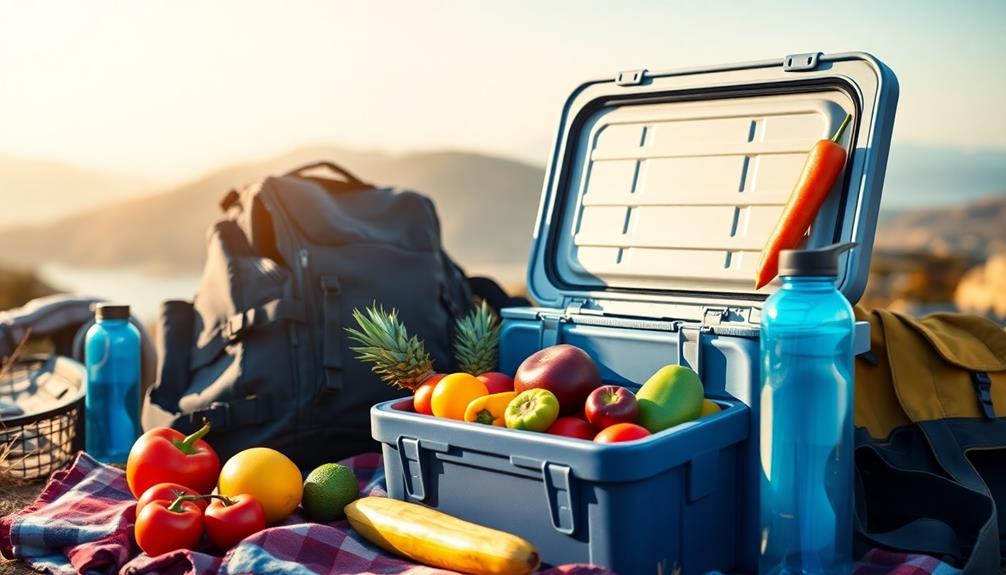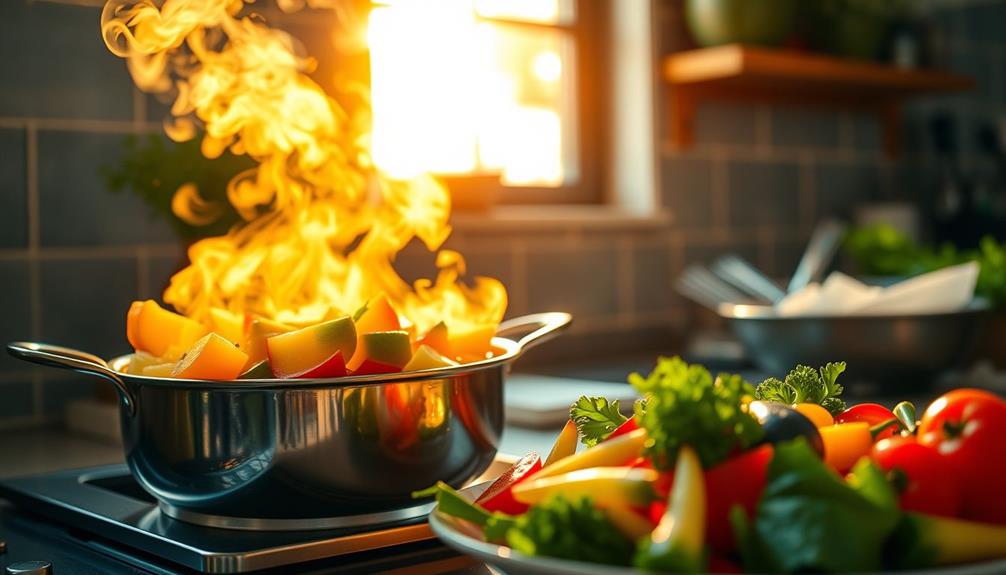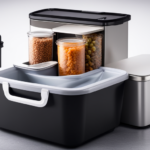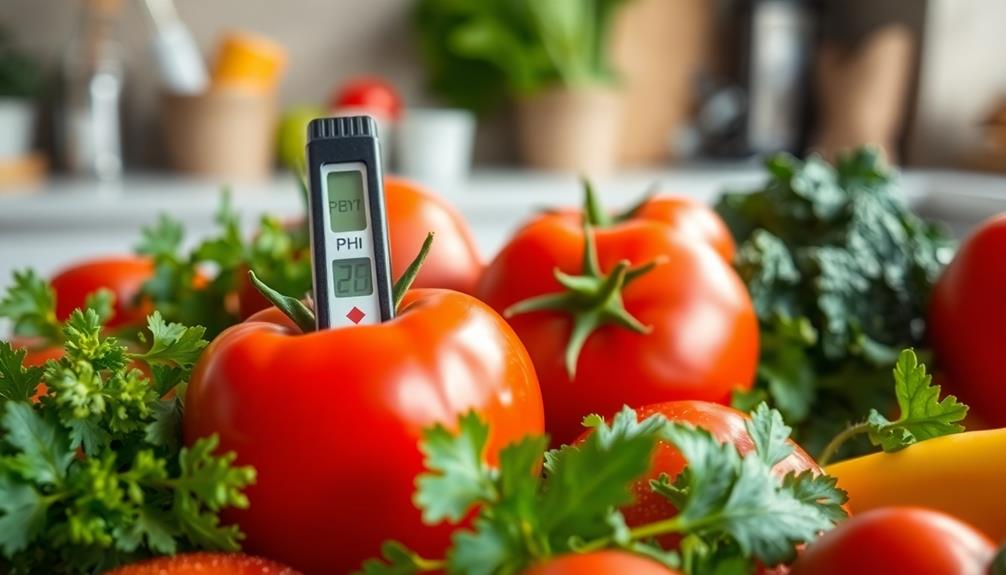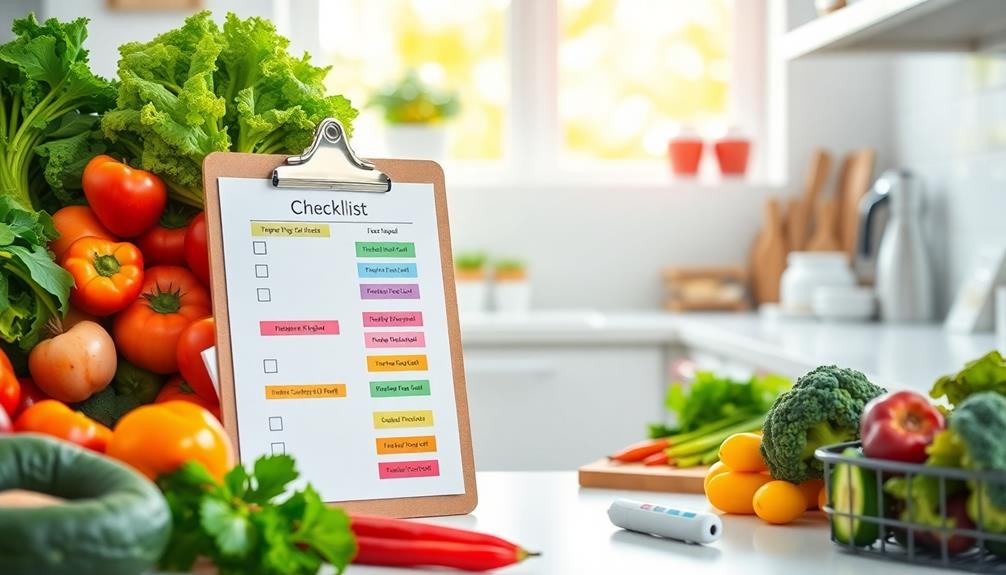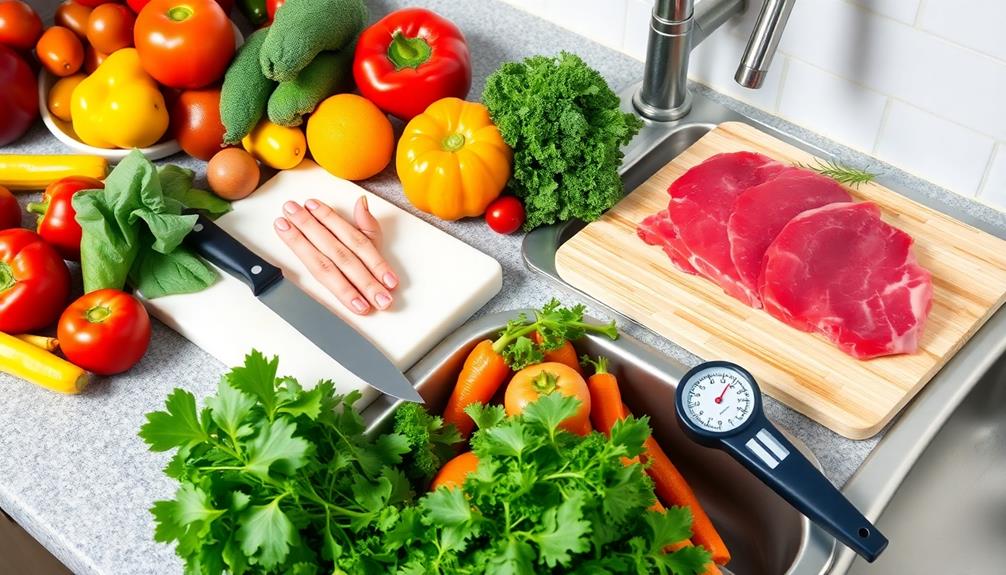When traveling with raw foods, you need to be proactive about safety. Stick to fruits and vegetables you can peel or wash with safe water. Avoid high-risk items like undercooked meats and raw seafood, especially in developing countries. Always wash your hands before handling food, and keep raw items in airtight containers to prevent spoilage. Choose bottled or canned drinks with intact seals, and skip ice in questionable areas. A little awareness goes a long way in protecting your health on the road. There's plenty more to reflect on, so keep exploring safe options to enhance your travel experience.
Key Takeaways
- Avoid raw foods, especially undercooked meats and seafood, in high-risk travel areas to reduce foodborne illness risks.
- Always wash fruits and vegetables with safe water or peel them before consumption to minimize contamination.
- Opt for packaged or canned beverages with intact seals to avoid contaminated water during travel.
- Practice proper hand hygiene by washing hands before meals to prevent foodborne illnesses while traveling.
- Store raw foods properly in coolers and keep them separate from cooked foods to avoid cross-contamination.
Importance of Food Safety
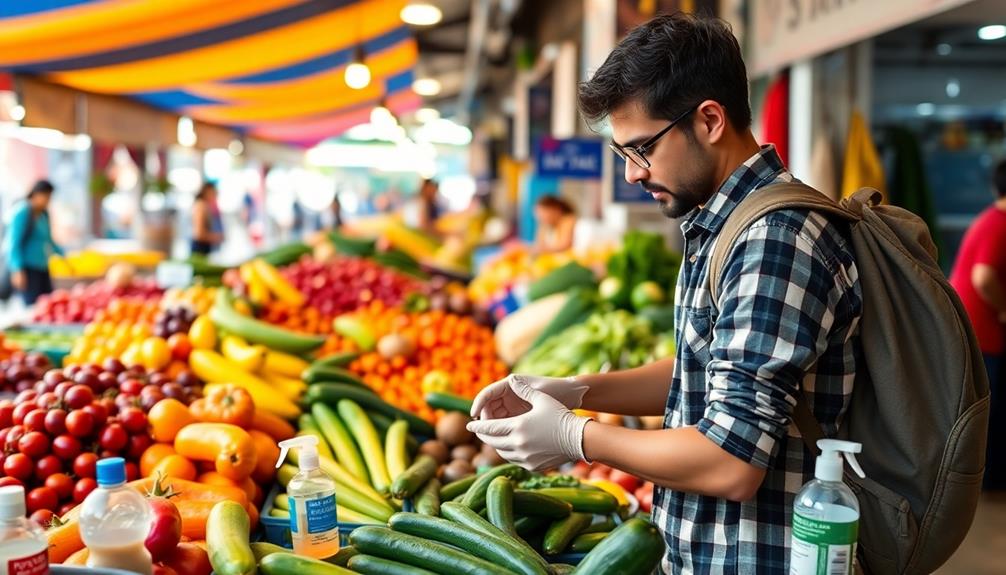
When you're traveling, food safety shouldn't be overlooked. It's crucial to guarantee that what you eat and drink won't lead to unpleasant experiences, like traveler's diarrhea, which affects millions annually. Developing countries often pose higher risks for foodborne illnesses due to inadequate sanitation and clean water supplies. That's why you need to stay vigilant about what you consume.
Choosing thoroughly cooked foods is one of the best ways to guarantee food safety; high heat effectively kills harmful germs. Dry foods, such as nuts and chips, are typically safe due to their low moisture content. However, be cautious with raw fruits and vegetables unless you can peel them yourself or wash them with safe water. Street food and local beverages can also carry risks, so think twice before indulging.
Practicing proper hygiene can greatly reduce your chances of contracting foodborne illnesses while on the go. Frequent handwashing and using hand sanitizer are essential habits to adopt.
Risk of Foodborne Illnesses
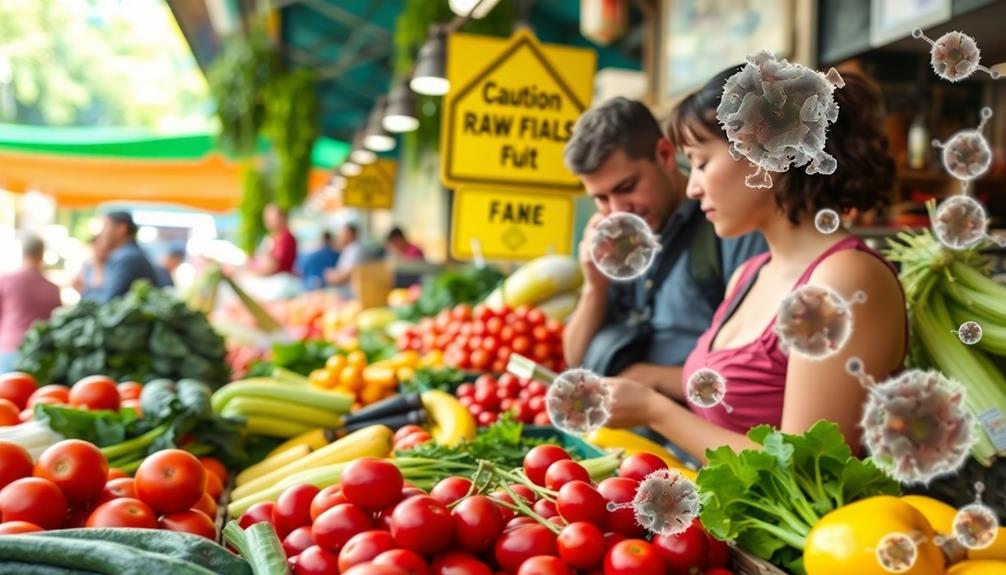
When you travel, the risk of foodborne illnesses can greatly increase, especially if you consume high-risk foods like undercooked meats and raw seafood.
You should be aware of common symptoms such as nausea and diarrhea, which can quickly ruin your trip.
To keep yourself safe, it's crucial to follow prevention strategies and stay informed about local food safety practices.
Common Symptoms Overview
Foodborne illnesses can strike unexpectedly and ruin your travel plans, leaving you grappling with a range of unpleasant symptoms. Common symptoms include nausea, vomiting, diarrhea, abdominal cramps, and fever, which can hit you within hours or days after consuming contaminated food or drinks. You might experience mild discomfort, but some travelers face severe symptoms that lead to dehydration and the need for medical attention.
According to the CDC, foodborne illnesses affect about 48 million people in the U.S. each year, resulting in around 128,000 hospitalizations and 3,000 deaths. Travelers are particularly vulnerable, especially in high-risk destinations like developing countries, where sanitation and food safety standards may fall short.
Recognizing the symptoms is essential, as they can vary in severity. By being aware of local food safety practices and potential high-risk foods, like undercooked meats and unpasteurized dairy, you can reduce your risk of experiencing the distressing effects of foodborne illnesses.
Staying alert and informed can help guarantee that your travels remain enjoyable and free from health issues.
High-Risk Foods Identified
Understanding the potential dangers of foodborne illnesses is essential for keeping your travels safe and enjoyable. Being aware of high-risk foods can help you avoid unnecessary health issues while exploring new destinations.
Consider these high-risk foods that might endanger your well-being:
- Undercooked meats that can harbor harmful bacteria
- Unpasteurized dairy products that may carry dangerous pathogens
- Raw seafood that can lead to severe gastrointestinal distress
Raw fruits and vegetables can also pose risks, especially if they haven't been washed or peeled. Contamination is more likely in areas with poor sanitation.
Additionally, foods left at room temperature, particularly in buffet settings, become breeding grounds for bacteria, heightening your risk of illness.
Street food might be tempting, but it often comes from inadequate cooking practices and unsanitary conditions. Always verify that your food is freshly prepared and properly cooked.
The Centers for Disease Control and Prevention (CDC) emphasizes the importance of caution with high-risk foods, especially in developing countries where food safety standards can vary widely.
Stay informed, and prioritize your health while enjoying your travels.
Prevention Strategies Emphasized
To guarantee a safe and enjoyable travel experience, it's vital to adopt effective prevention strategies against foodborne illnesses. When traveling, especially in developing countries across Asia, Africa, and Latin America, you should avoid consuming raw foods, particularly undercooked meats, seafood, and eggs. These items are common sources of contamination that can lead to serious health issues.
Maintaining proper hand hygiene is essential. Always wash your hands with soap and water before eating or handling food. This simple act greatly reduces the likelihood of transferring harmful pathogens to your body.
Additionally, opt for packaged or sealed beverages to steer clear of contaminated water sources, and avoid ice made from tap water in areas with questionable sanitation practices.
It's also important to stay vigilant about the symptoms of foodborne illnesses, which can include nausea and diarrhea. If you experience severe symptoms or if they persist, seek medical attention promptly, especially when in high-risk areas.
Safe Raw Food Choices
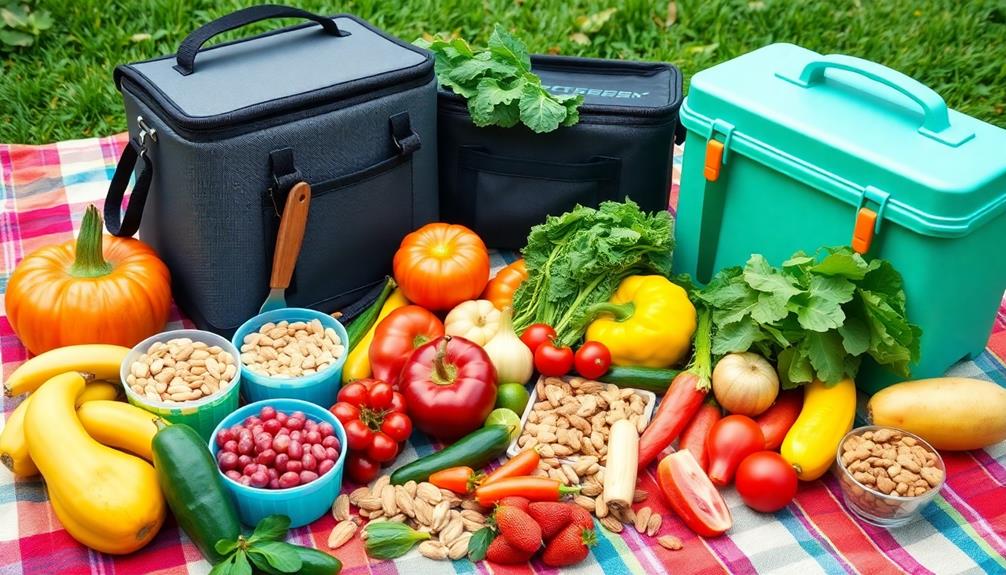
When traveling, you want to make smart choices about raw food to keep yourself safe.
Opt for fresh produce that you can peel or wash thoroughly, and always store your snacks properly to avoid spoilage.
Staying hydrated with safe water is essential, so know your options and prioritize your health while on the go.
Choosing Fresh Produce
Choosing fresh produce is vital for maintaining food safety while traveling. When you're on the go, selecting the right fruits and vegetables can considerably reduce your risk of foodborne illness. Incorporating nutrient-dense options, such as chia seeds, can also complement your fresh produce intake while providing added health benefits like increased satiety and reduced cravings for unhealthy snacks benefits of chia seeds.
Here are some tips to guarantee you make safe food choices:
- Opt for whole fruits and vegetables with intact skins. This minimizes your risk of contamination since peeling can expose you to harmful bacteria.
- Choose organic produce whenever possible. It's less likely to be treated with harmful pesticides and often adheres to stricter safety standards.
- Always wash your fruits and vegetables thoroughly with safe water before eating them raw. This vital step removes potential contaminants.
Additionally, purchase your produce from reputable sources, like well-known grocery stores or local farmers' markets. These places typically enforce better food safety practices.
Avoid pre-cut or pre-packaged fruits and vegetables, as they've a higher risk of exposure to pathogens due to handling and processing. By following these guidelines, you can enjoy fresh produce safely and confidently during your travels, making your culinary adventures both delicious and secure.
Safe Storage Practices
After selecting fresh produce, how you store it is equally important for maintaining food safety while traveling. To keep your raw food fresh, use a portable cooler with ice packs. This setup helps prevent spoilage and keeps your fruits and vegetables crisp.
For pre-portioned raw meals, opt for airtight containers or resealable bags. These safe storage practices protect against contamination and extend the shelf life of your food. Additionally, incorporating a variety of raw fruits and vegetables can enhance nutrient density, which is a key benefit of the raw food diet.
It's essential to keep raw foods separate from cooked foods, especially in shared storage spaces. This separation minimizes the risk of cross-contamination, which can lead to foodborne illnesses.
If you're looking for lightweight options, consider freeze-dried or dehydrated raw foods. They're shelf-stable, maintain their nutritional value, and don't require refrigeration.
Lastly, always monitor the temperature of your stored raw food. Confirm it stays below 40°F (4°C) to inhibit the growth of harmful bacteria.
Hydration and Safety
Staying hydrated is essential for your overall well-being while traveling, especially when consuming raw foods. Proper hydration helps you avoid false hunger signals, which can lead you to make unsafe food choices.
Additionally, maintaining good air quality can also support your health during travel, as air purifiers help reduce allergens. Always opt for bottled or canned beverages with intact seals, particularly in areas where water quality is questionable.
To guarantee your hydration is safe and effective, keep these tips in mind:
- Choose bottled water for drinking and brushing your teeth to avoid harmful pathogens.
- Select fruits and vegetables that can be peeled, like bananas and oranges, to reduce contamination risks.
- Enjoy fresh juices or smoothies made from pasteurized products or in clean environments to prevent foodborne illnesses.
Beverage Safety Guidelines
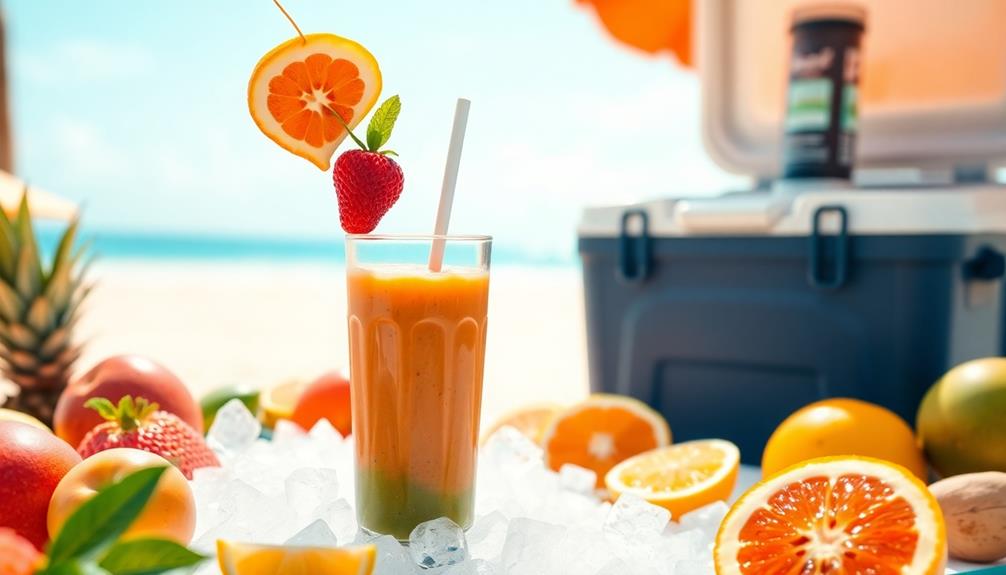
How can you guarantee your beverages are safe while traveling? Following a few simple beverage safety guidelines can help you avoid potential health issues.
Always choose canned and bottled beverages that have intact seals. This minimizes the risk of contamination and ascertains you're consuming safe drinks.
When it comes to water, avoid drinking tap water in developing countries unless it's been properly treated. Bottled water is your best option. Be cautious with ice in your drinks, as it may be made from contaminated tap water. Opting for beverages without ice is a safer choice.
If you enjoy dairy, stick to pasteurized milk and dairy products. Unpasteurized options can expose you to foodborne illnesses, so it's best to steer clear.
Additionally, when in doubt about the local water quality, use bottled water even for brushing your teeth. This helps you avoid ingesting unsafe water that could lead to health problems.
At-Risk Travel Destinations
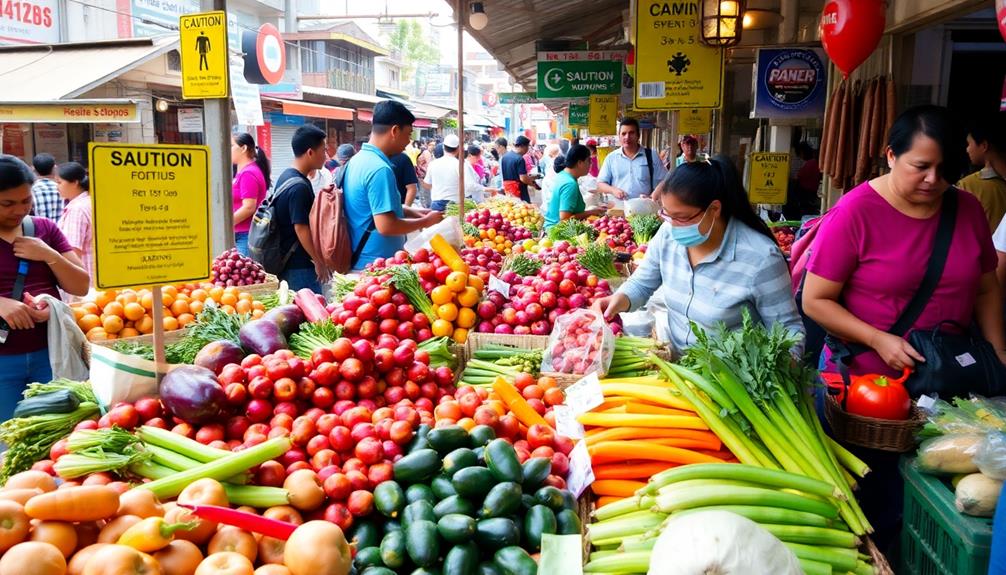
Many travelers unknowingly put themselves at risk when visiting certain destinations, particularly in developing countries. Places like India, Mexico, and most of Africa pose significant challenges due to inadequate sanitation and limited access to clean water.
As a traveler, you should be aware of the dangers of consuming contaminated food, which can lead to serious health issues.
- Imagine spending your vacation in bed, battling foodborne illness instead of exploring vibrant markets.
- Picture the disappointment of missing out on local cuisine because your body's not cooperating.
- Think about the potential long-term health effects that can arise from unsafe eating habits abroad.
The CDC warns that travelers to high-risk areas can see rates of travelers' diarrhea soar up to 70%. Food safety varies widely by region, making your research essential.
Avoid raw fruits and vegetables unless they're safely peeled or washed with treated water. When exploring these destinations, prioritize your health by being cautious with what you eat.
The thrill of travel shouldn't come with the risk of contaminated food ruining your experience. Stay informed, and enjoy your journey safely!
Pre-Travel Food Preparation
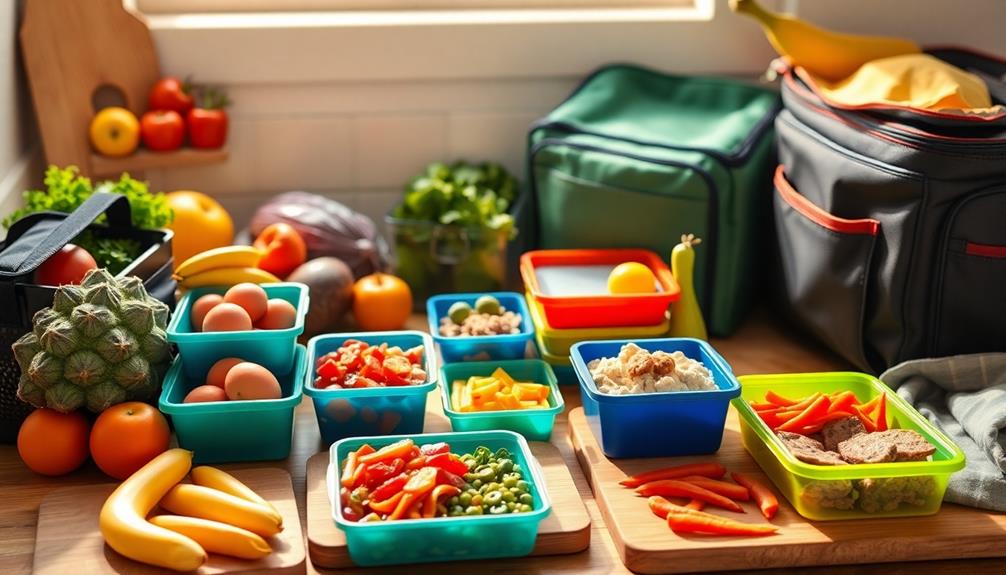
Before you commence your adventure, consider the importance of pre-travel food preparation. Eating a nutritious meal before departure helps prevent extreme hunger, reducing the likelihood of impulsive unhealthy eating choices during your travels.
One effective strategy is preparing a salad in a container with lemon or orange wedges for dressing. This not only simplifies meal options but also guarantees you have access to fresh produce during your journey.
Another great option is packing raw hummus with assorted cut vegetables. This creates a convenient and healthy snack that's easy to prepare and transport.
If you prefer something even simpler, consider mono meals, consisting of a single type of fruit. They minimize preparation time while making food choices straightforward.
Advanced planning for your meals can help you maintain a raw food diet while traveling. By organizing your food in advance, you'll guarantee access to nutrient-rich options, which reduces travel-related stress.
Packing Raw Foods for Travel
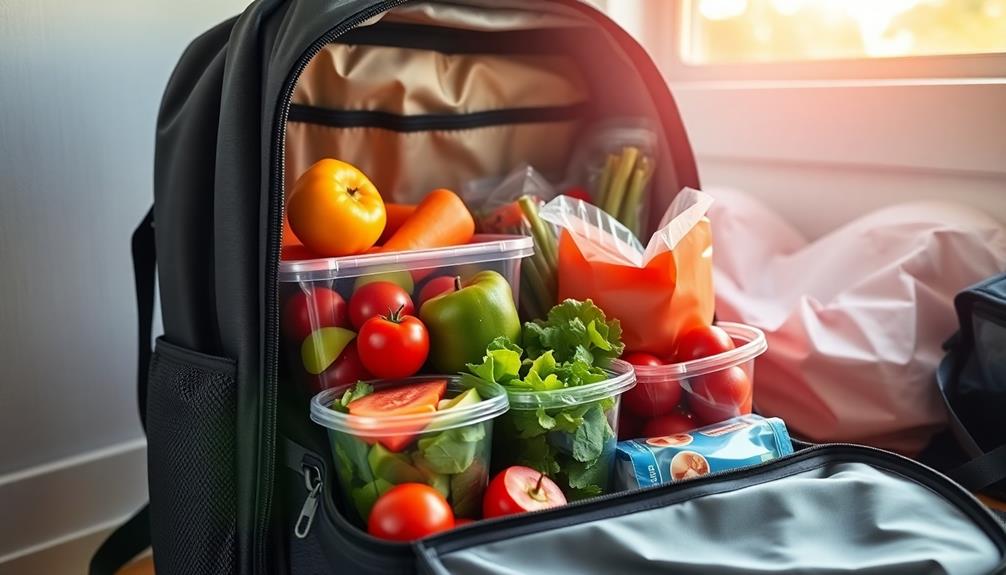
When it comes to packing raw foods for travel, choosing lightweight and shelf-stable options can make all the difference. Freeze-dried fruits and dehydrated snacks are great choices since they don't require refrigeration and can be easily rehydrated with water.
For short trips, take into account using portable coolers with ice packs to keep perishable items fresh. Remember to store these foods in airtight containers to prevent spoilage.
Here are some must-pack items to take into account:
- Freeze-dried berries: Perfect for a quick energy boost!
- Dehydrated veggie chips: Crunchy and satisfying, without the guilt!
- Vacuum-sealed raw meals: Convenient and fresh, ready to go!
Planning your meals around your travel schedule is essential. This strategy allows you to accommodate any restrictions on food handling or storage while ensuring you stick to your raw food diet.
Don't forget to research local grocery stores or markets at your destination. This way, you can stock up on fresh produce upon arrival, keeping your raw food options plentiful throughout your trip.
Handling Raw Food Safely
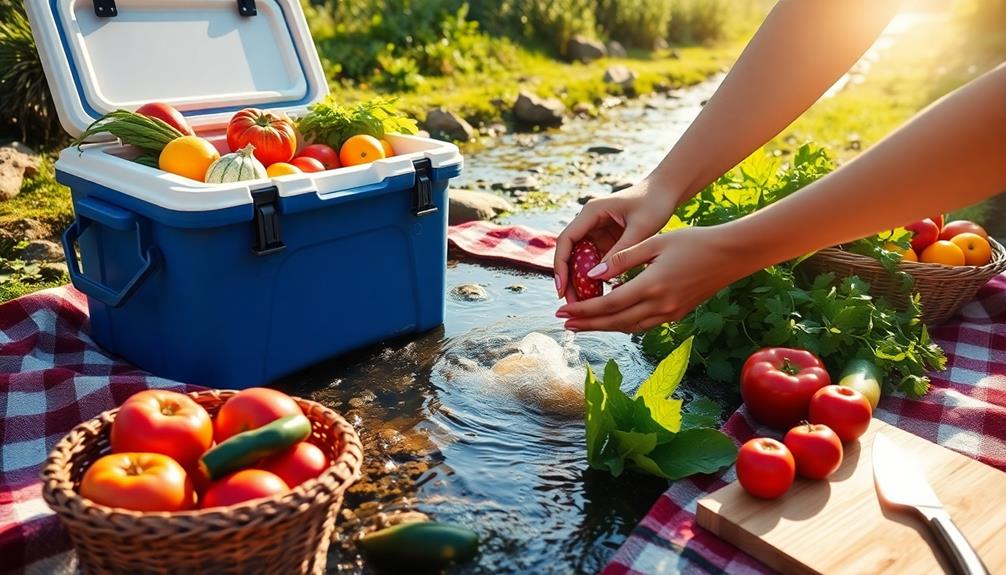
When you're handling raw food, hygiene and safe storage are essential.
Always wash your hands and use separate cutting boards for fruits and veggies to keep harmful bacteria at bay.
Additionally, make sure to store your raw foods in airtight containers and keep them chilled to minimize any risk during your travels.
Safe Storage Practices
During your travels, safe storage practices for raw food are essential to prevent spoilage and contamination. Start by using airtight containers or resealable bags to keep your food safe from moisture and contaminants. This simple step can make a big difference in maintaining your food's freshness and flavor.
To guarantee your raw food stays safe, consider the following:
- Avoid the dreaded food poisoning!
- Enjoy every bite without worry!
- Keep your meals nutritious and delicious!
When packing perishables, keep them cool with ice packs in your cooler, guaranteeing the temperature stays below 40°F (4°C). Regularly check the temperature with a thermometer, and toss any food that shows signs of spoilage.
Opt for foods with longer shelf lives, like freeze-dried or dehydrated fruits, which don't need refrigeration and still pack a nutritional punch.
If you're using a portable cooler, remember to replenish ice packs frequently and avoid placing it in direct sunlight. By following these safe storage practices, you can enjoy your travels without the fear of unsafe food.
Hygiene and Preparation Tips
Raw food safety hinges on good hygiene and proper preparation. Before you engage in handling raw food, always wash your hands thoroughly with soap and warm water. This simple step minimizes the risk of cross-contamination and foodborne illness.
When you're chopping up your fruits and vegetables, remember to use separate cutting boards—this helps keep any potential contamination from raw meats at bay.
As you prepare your raw meals, make sure all surfaces and utensils are cleaned with disinfectant wipes or soap and water. This practice eliminates harmful bacteria that could ruin your meal or make you sick.
Planning ahead is key, so pack your raw food items in airtight containers to maintain freshness and prevent exposure to contaminants while you travel.
If you suspect that the raw food may not be safe due to poor hygiene practices or food handling at your travel destination, consider temporarily switching to lightly cooked meals. This precaution can help you avoid any food-related issues during your trip.
Finding Local Raw Options
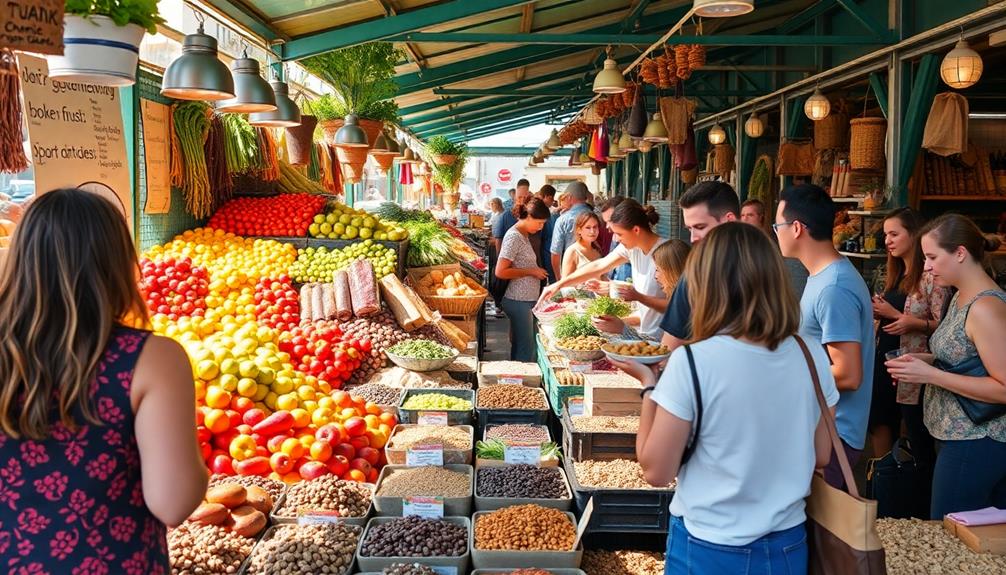
Traveling doesn't mean you have to compromise your raw food lifestyle. With a bit of planning, you can discover delicious local raw options that keep you energized and satisfied on your journey.
Start by researching local markets or grocery stores at your destination; many areas boast organic or health-focused shops brimming with fresh produce.
You can also utilize apps and websites that specialize in vegan or raw food restaurants. They can lead you to nearby dining spots that cater to your dietary needs.
Consider engaging with local communities or groups centered on raw or healthy eating, as they often provide great recommendations for markets and eateries.
Don't forget to check out local farmers' markets—they frequently feature fresh, organic fruits and vegetables, making it easier to maintain your raw lifestyle while traveling.
You might even stumble upon local cuisine with potential raw dishes, like salads or fruit platters, that you can adapt to fit your preferences.
- Feel the joy of discovering new flavors!
- Savor the freshness of locally sourced ingredients!
- Connect with like-minded individuals who share your passion!
Finding local raw options is an adventure waiting to happen.
Tips for Healthy Eating Abroad
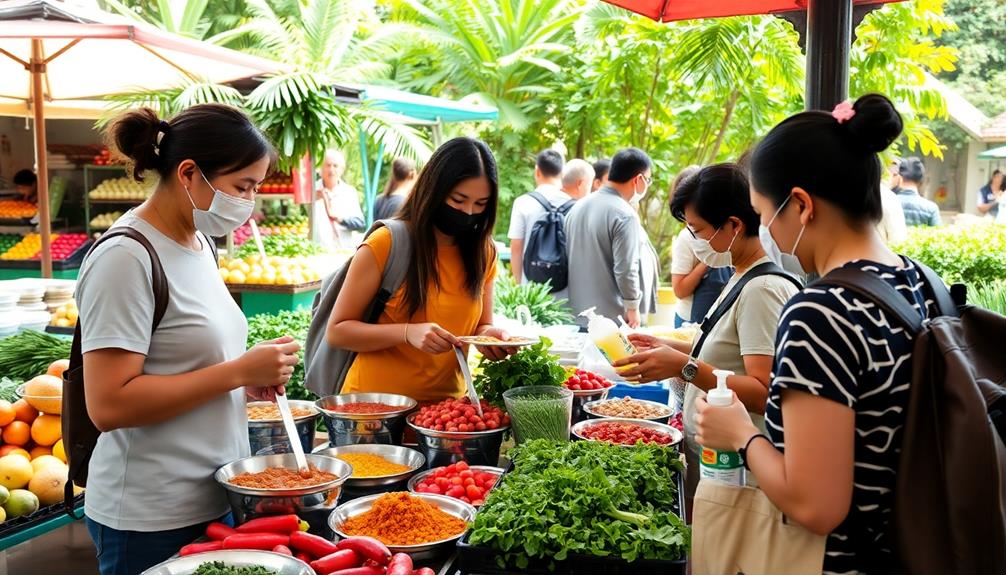
Maintaining a healthy diet while abroad can be a rewarding experience, but it requires some strategic planning. Start by researching local markets and grocery stores at your destination to find fresh produce and raw food options that suit your dietary preferences. This not only helps you discover new ingredients but also connects you with local culture.
To avoid unhealthy impulse purchases, bring along portable snacks like raw energy bars, nuts, and dried fruits. These will keep you energized during your travels.
If possible, opt for accommodations with kitchen facilities. Preparing your own meals guarantees you have access to safe and nutritious raw food options.
When enjoying raw fruits and vegetables, always wash them with safe water or peel them to minimize the risk of foodborne illnesses, especially in areas with questionable sanitation.
Frequently Asked Questions
How Do You Travel With Raw Food?
When you travel with raw food, choose lightweight, shelf-stable options, and pack them securely. Use coolers for perishables, pre-portion meals, and include non-perishable snacks to keep hunger at bay during your journey.
How to Keep Food Fresh While Traveling?
To keep food fresh while traveling, pack airtight containers, use ice packs, and choose non-perishables. Regularly check temperatures, replace ice, and prioritize items that don't need refrigeration, ensuring your meals stay delicious and safe.
Can You Travel With Raw Meat?
Yes, you can travel with raw meat, but it's risky. You'll need to keep it cold, check airline policies, and prevent cross-contamination. Consider buying fresh meat at your destination for safer options.
How to Not Get Food Poisoning When Traveling?
To keep your tummy happy on your adventures, stick to well-cooked dishes, sip bottled drinks, and peel or wash fruits and veggies. Stay alert for food stalls with fresh options, avoiding those that look questionable.
Conclusion
When you're traveling, think of food safety as your trusty compass—guiding you away from the pitfalls of foodborne illnesses. Just like you'd avoid a rocky cliff on a hike, steer clear of risky raw options in at-risk destinations. Remember a friend who got sick after a salad in a foreign market—don't let that be you! By choosing safe raw foods and following guidelines, you can enjoy the adventure of local flavors without the fear of an unwelcome detour.

